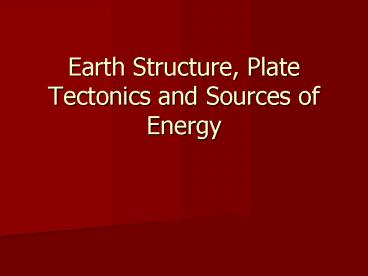Earth Structure, Plate Tectonics and Sources of Energy - PowerPoint PPT Presentation
1 / 28
Title:
Earth Structure, Plate Tectonics and Sources of Energy
Description:
Earth experienced a period of internal melting (due to initial high ... igneous (= fire), sediments (=settled particles) metamorphic rocks (transformed rocks) ... – PowerPoint PPT presentation
Number of Views:121
Avg rating:3.0/5.0
Title: Earth Structure, Plate Tectonics and Sources of Energy
1
Earth Structure, Plate Tectonics and Sources of
Energy
2
Structure of the Earth Interior
The process of forming the Earth was complete by
about 4.5 billion years ago.
Dense elements (especially iron and nickel) sank
to the centre of the Earth, forming the metallic
core.
3
Lighter material rose to the surface (forming a
thin, weak, crust).
Initial crust was likely too support plate
tectonics as we know it today.
4
The Earths interior
1000 C
4000 C
7000 C
5
Pea-soup analogy
Process of heat energy transfer
6
mantle convection
- Heat transfer from the core to the
- mantle produces slow convection
- of the mantle material
(in the order of centimetres per year)
7
Mantle convection produces lateral forces at the
boundary between the mantle and the crust
8
Lateral forces at the crust-mantle boundary push
the crust around in different directions and
this leads to the motion of crustal plates. The
plates are moving at rates of cm/year
9
14 major plates of Earths crust Scotia plate
10
(No Transcript)
11
Plate motions
12
Transform boundary
13
Source http//visearth.ucsd.edu/VisE_Int/aralsea/
bigone.html
14
Divergent boundary
15
(No Transcript)
16
The Plate Tectonics Model
17
Convergent boundary
Subduction
18
(No Transcript)
19
Plates around North America
20
(Source U.S. Geological Survey).
21
Why Does Plate Tectonics Occur?
22
Energy
- Energy can exist in many different forms, and
comes from a variety of sources. - Natural disasters occur when there is a sudden
release of the energy near the surface of the
Earth.
23
Sources of Energy
- Two basic sources
- Solar Energy and Internal Geothermal Energy
- Solar Energy
- Solar Energy drives the water cycle, causing
evaporation of the oceans and circulation of the
atmosphere, which allows rain to fall on the land
and run downhill. Thus solar energy is
responsible for such natural disasters as severe
weather, and floods.
24
Internal Energy
- only amounts to 0.013 of total energy
reaching the Earth's surface, but is responsible
for deformational events mountains, earthquakes
and volcanism - Important sources of internal energy
- Radioactive decay
25
The Rock Cycle
Energy for the parts of the crustal cycle near
the Earth's surface is solar and gravitational
energy (which control erosion and
weathering). Energy that drives processes beneath
the surface is geothermal and gravitational
energy (which control uplift, subsidence,
melting, and metamorphism).
Source http//www.tulane.edu/sanelson/geol204/st
ructmaterials.htm
26
A variety of processes act on and within the
Earth - here we consider those responsible for
Natural Disasters
- Melting - responsible for creating magmas that
result in volcanism. - Deformation - responsible for earthquakes,
volcanism, landslides, subsidence. - Weathering - responsible for landslides,
subsidence. - Erosion - responsible for landslides, subsidence,
flooding. - Atmospheric Circulation - responsible for
hurricanes, tornadoes, flooding.
27
- rocks into three major classes
- igneous ( fire),
- sediments (settled particles)
- metamorphic rocks (transformed rocks)
- Within each division there are many groups and
types
28
(No Transcript)

